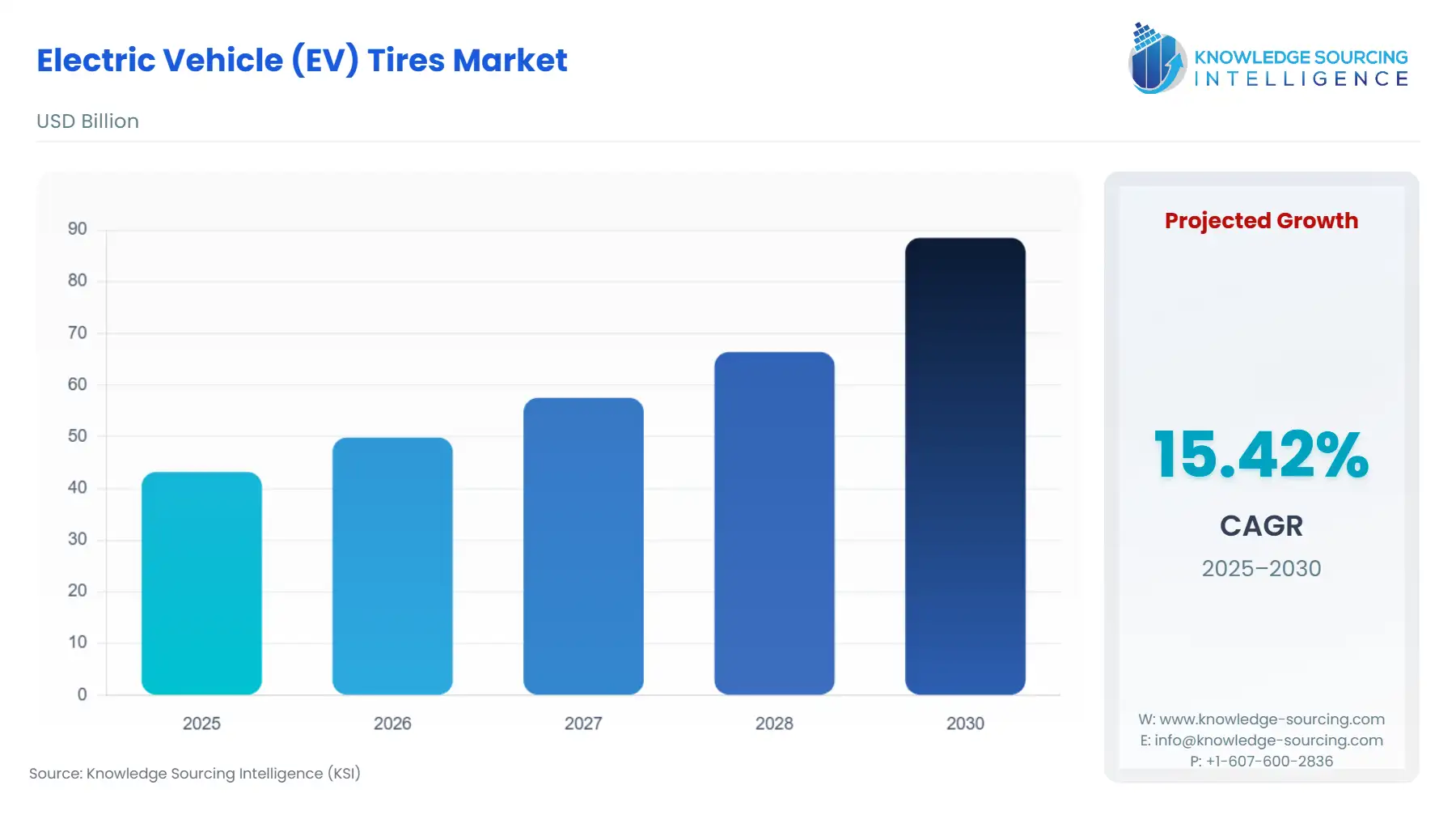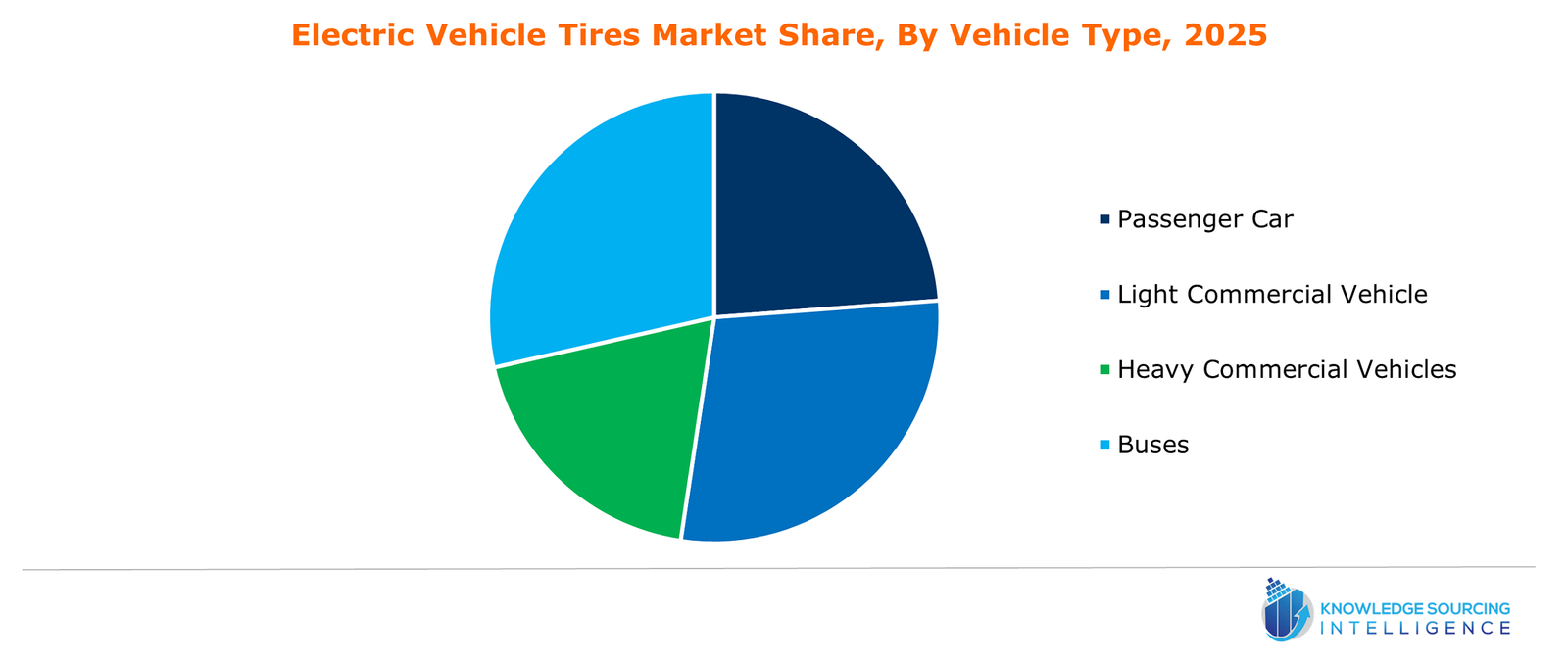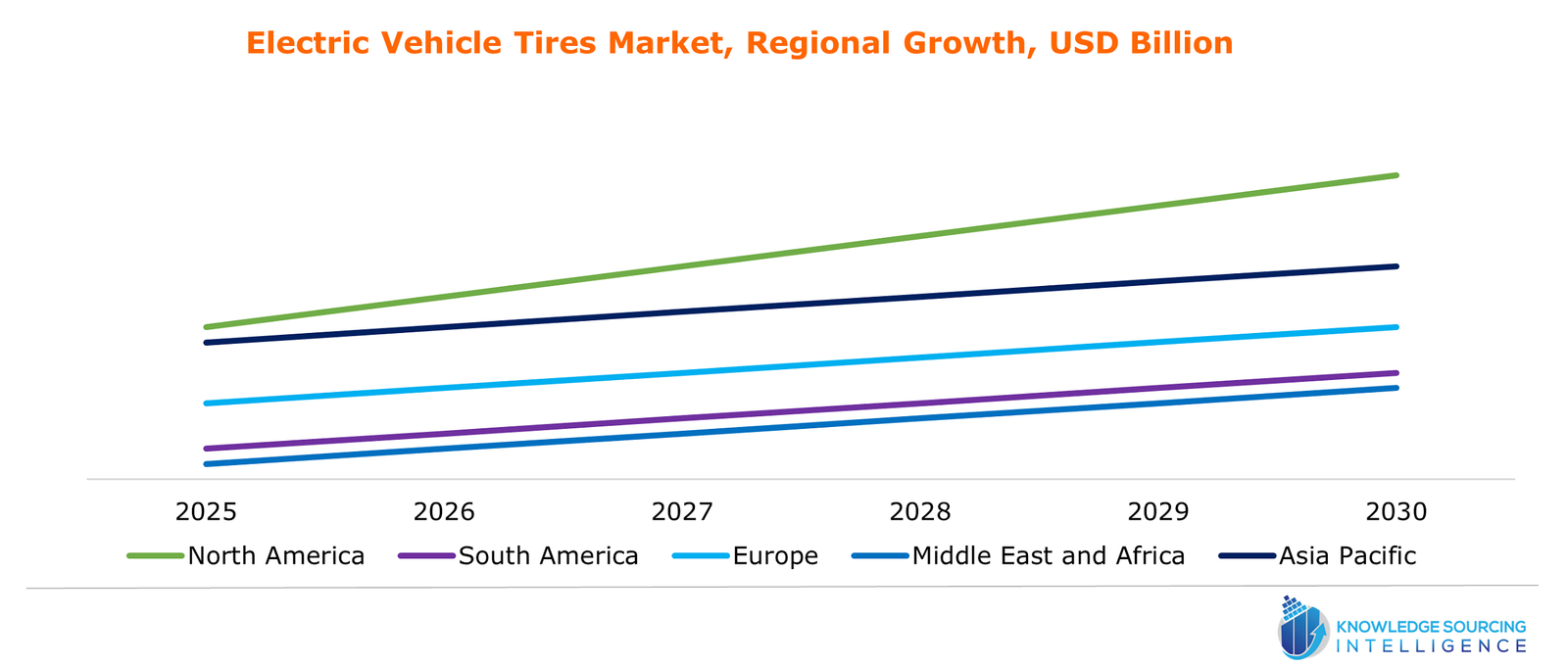Electric Vehicle Tires Market - Strategic Insights and Forecasts (2025-2030)
Description
Electric Vehicle Tires Market Size:
The electric vehicle (EV) tires market will grow from US$43.196 billion in 2025 to US$88.498 billion in 2030 at a CAGR of 15.42%.
Electric Vehicle Tires Market Highlights:
- EV adoption is driving demand: Rising electric vehicle sales are boosting tire market growth.
- IoT integration is enhancing tires: Smart tire innovations are improving efficiency and connectivity globally.
- Asia Pacific is leading expansion: China and Japan are dominating EV tire production.
- Eco-friendly features are gaining traction: Low-emission tires are aligning with sustainability trends.
Electric vehicle (EV) tires are specially designed tires that are made to support electric vehicles because of their unique design and architecture. These tires are quieter than conventional tires and are preferred for EVs that are quieter than combustion engines. As the EV engines are quieter, they need to cancel out the noise produced by the tires and prevent it from reaching the passengers. Compared to combustion cars, EVs drive technology lowers maintenance, emissions, engine noise, and running costs.

To learn more about this report, request a free sample copy
However, one consequence of electric vehicles' many benefits is a major weight increase. Batteries are heavy, and their weight puts a strain on EV tires. Choosing the right tires for electric vehicles is essential to maintaining mileage, braking performance, and efficiency. Additionally, with high instant torque and increased weight, the demand for long-range and lower emissions comes with an even greater need for minimal rolling resistance, so tires for electric cars offer a smoother, more energy-efficient, and low-impact ride.
Electric Vehicle Tires Market Trends:
The electric vehicle tires market is driven primarily by the increasing demand for EVs and their adoption as commercial vehicles, such as electric buses, trucks, and vans. These tires are equipped with technology that is different from traditional combustion engine tires, making the vehicle quieter. Tires can impact the overall performance and efficiency of the vehicle, so it is an essential part of EVs, with an increase in demand, propelling the electric vehicle tires market growth.
The adoption of IoT (Internet of Things) enabled devices is driving market growth. These devices are a major part of the development process of the automotive industry and have been a significant part of this industry in recent times, accelerating the growth and development of electric vehicle smart tires. Major tire manufacturers are developing the functionality of smart tires that depend upon IoT connectivity to deliver more efficient and reliable tires.
Electric Vehicle Tires Market Growth Drivers:
- The Adoption of EVs for commercial and personal use is predicted to propel the electric vehicle tire market
The demand for EVs has seen rapid market growth for better efficiency and more eco-friendly options for the general public. This, in turn, is increasing the demand for appropriate tires that go with these EVs, which have different requirements for a tire than a traditional car tire. These smart tires, or connected tires, are mainly used in new-generation electric vehicles. Therefore, the EV tire market growth is prominent in the forecast period. For instance, the American government is investing heavily in public and private sectors to provide affordable electric vehicles, which will turn up EV sales and, in turn, EV tire sales.
- The adoption of the IoT-enabled smart devices market trend is projected to drive the electric vehicle tires market.
The acceptance of IoT in the global automotive industry and the rising demand for connectivity in IoT are helping in innovations and new developments in EV tires. Many major tire manufacturers are moving towards IoT connectivity to increase efficiency, driving market growth.
- The enhanced features of EV tires are anticipated to propel market growth.
According to electric vehicle specifications, the specially developed tires produce less carbon emission than traditional combustion engine vehicle tires during manufacturing. These tires also produce less sound than traditional tires, which goes perfectly with EVs, as they are quieter than fuel-engine vehicles, and the sound does not reach the passenger sitting in the driving seat. The added weight of EV batteries provides improved road resistance and stiffness.

Electric Vehicle Tires Market Restraints:
The use of high-performance tires results in efficient and smooth EV rides. Electric vehicles produce more power and torque than traditional fuel-engine vehicles, increasing the strain on the tires because they have heavy batteries. This reduces their lifespan as they wear down 20% faster than fuel engine tires because of these vehicles' acceleration. These tires are more expensive than traditional car tires due to their enhanced features. However, their high cost and low lifespan might hinder the market growth of electric vehicle tires in the forecast period.
Electric Vehicle Tires Market Geographical Outlook:
- The Asia Pacific region is expected to dominate the electric vehicle (EV) tires market.
The Asia Pacific region is expected to show major growth in the electric vehicle tires industry. This growth is attributed to the rapid increase in production and demand for the electric vehicle industry in countries like Japan, South Korea, and China. The rising demand for eco-friendly vehicles is driving growth in this region, with key players like Toyota, Honda, and others.
Furthermore, the development of infrastructure for electric vehicles, along with government initiatives promoting their use for both commercial and personal purposes, is driving significant technological advancements in these regions. This, in turn, is expected to boost the market growth of electric vehicle tires during the forecast period in the Asia Pacific region.

Electric Vehicle Tires Market Key Players and Products:
- Yokohama: The ADVAN Apex® V601 is one of the tires produced specially for electric vehicles. It is used for ultra-high-performance cars that demand an ultra-high-performance tire. It is designed to redefine grip and dominate U.S. roads with a strong sidewall and tread, delivering a precise and immediate cornering response. It also has rigid construction and optimized groove angles to minimize road noise, providing a quieter road trip.
- Michelin Tires: DEFENDER LTX PLATINUM is a product that is suitable for electric vehicles and provides the best performance and efficiency. It delivers exceptional tread life and cutting-edge aesthetics with a new class of tires developed specifically for luxury heavy-duty pickup trucks. It includes an ultra-premium design with a striking velour sidewall. It is designed to last twice as long as the previous generation, providing drivers with a smooth and classy ride the whole journey with these tires.
Electric Vehicle Tires Market Key Developments:
- In January 2024, Yokohama Tires launched its product, the new ADVAN Sport® EV A/S, in the US market. These tires are an ultra-high-performance all-season tire specifically designed for electric vehicles. It’s the first tire to carry the new E+ badge, which is important for EV tires, and it signifies that the tire can fulfill the unique set of requirements brought by EVs and its compatibility with electric vehicles.
List of Top Electric Vehicle Tire Companies:
- Yokohama
- Smithers
- Michelin Tires
- Continental Tire
- Hankook USA
Electric Vehicle Tires Market Scope:
| Report Metric | Details |
| Electric Vehicle Tires Market Size in 2025 | US$43.196 billion |
| Electric Vehicle Tires Market Size in 2030 | US$88.498 billion |
| Growth Rate | CAGR of 15.42% |
| Study Period | 2020 to 2030 |
| Historical Data | 2020 to 2023 |
| Base Year | 2025 |
| Forecast Period | 2025 – 2030 |
| Forecast Unit (Value) | USD Billion |
| Segmentation |
|
| Geographical Segmentation | North America, South America, Europe, Middle East and Africa, Asia Pacific |
| List of Major Companies in Electric Vehicle Tires Market |
|
| Customization Scope | Free report customization with purchase |
Electric Vehicle (EV) Tires Market Segmentation:
- By Propulsion Type
- Battery Electric Vehicle (BEV)
- Plug-in Hybrid Electric Vehicle (PHEV)
- Hybrid Electric Vehicle (HEV)
- Fuel Cell Electric Vehicle (FCEV)
- By Vehicle Type
- Passenger Car
- Light Commercial Vehicle
- Heavy Commercial Vehicles
- Buses
- By Application
- On-road
- Off-road
- By Sales Channel
- OEM
- Aftermarket
- By Geography
- North America
- United States
- Canada
- Mexico
- South America
- Brazil
- Argentina
- Others
- Europe
- United Kingdom
- Germany
- France
- Italy
- Spain
- Others
- Middle East and Africa
- Saudi Arabia
- United Arab Emirates
- Others
- Asia Pacific
- China
- India
- Japan
- South Korea
- Taiwan
- Thailand
- Indonesia
- Others
- North America
Our Best-Performing Industry Reports:
Frequently Asked Questions (FAQs)
The electric vehicle tires market is expected to reach a total market size of US$88.498 billion by 2030.
Electric Vehicle Tires Market is valued at US$43.196 billion in 2025.
The electric vehicle tires market is expected to grow at a CAGR of 15.42% during the forecast period.
EV tire market growth is driven by rising EV adoption, demand for low rolling resistance, durability, sustainability, and tech advances.
The Asia Pacific region is anticipated to hold a significant share of the electric vehicle tires market.
Table Of Contents
1. INTRODUCTION
1.1. Market Overview
1.2. Market Definition
1.3. Scope of the Study
1.4. Market Segmentation
1.5. Currency
1.6. Assumptions
1.7. Base and Forecast Years Timeline
1.8. Key benefits for the stakeholders
2. RESEARCH METHODOLOGY
2.1. Research Design
2.2. Research Process
3. EXECUTIVE SUMMARY
3.1. Key Findings
4. MARKET DYNAMICS
4.1. Market Drivers
4.2. Market Restraints
4.3. Porter’s Five Forces Analysis
4.3.1. Bargaining Power of Suppliers
4.3.2. Bargaining Power of Buyers
4.3.3. The Threat of New Entrants
4.3.4. Threat of Substitutes
4.3.5. Competitive Rivalry in the Industry
4.4. Industry Value Chain Analysis
4.5. Analyst View
5. ELECTRIC VEHICLE (EV) TIRES MARKET BY PROPULSION TYPE
5.1. Introduction
5.2. Battery Electric Vehicle (BEV)
5.3. Plug-in Hybrid Electric Vehicle (PHEV)
5.4. Hybrid Electric Vehicle (HEV)
5.5. Fuel Cell Electric Vehicle (FCEV)
6. ELECTRIC VEHICLE (EV) TIRES MARKET BY VEHICLE TYPE
6.1. Introduction
6.2. Passenger Car
6.3. Light Commercial Vehicle
6.4. Heavy Commercial Vehicles
6.5. Buses
7. ELECTRIC VEHICLE (EV) TIRES MARKET BY APPLICATION
7.1. Introduction
7.2. On-road
7.3. Off-road
8. ELECTRIC VEHICLE (EV) TIRES MARKET BY SALES CHANNEL
8.1. Introduction
8.2. OEM
8.3. Aftermarket
9. ELECTRIC VEHICLE (EV) TIRES MARKET BY GEOGRAPHY
9.1. Introduction
9.1. North America
9.1.1. By Propulsion Type
9.1.2. By Vehicle Type
9.1.3. By Application
9.1.4. By Sales Channel
9.1.5. By Country
9.1.5.1. United States
9.1.5.2. Canada
9.1.5.3. Mexico
9.2. South America
9.2.1. By Propulsion Type
9.2.2. By Vehicle Type
9.2.3. By Application
9.2.4. By Sales Channel
9.2.5. By Country
9.2.5.1. Brazil
9.2.5.2. Argentina
9.2.5.3. Others
9.3. Europe
9.3.1. By Propulsion Type
9.3.2. By Vehicle Type
9.3.3. By Application
9.3.4. By Sales Channel
9.3.5. By Country
9.3.5.1. United Kingdom
9.3.5.2. Germany
9.3.5.3. France
9.3.5.4. Italy
9.3.5.5. Spain
9.3.5.6. Others
9.4. Middle East and Africa
9.4.1. By Propulsion Type
9.4.2. By Vehicle Type
9.4.3. By Application
9.4.4. By Sales Channel
9.4.5. By Country
9.4.5.1. Saudi Arabia
9.4.5.2. United Arab Emirates
9.4.5.3. Others
9.5. Asia Pacific
9.5.1. By Propulsion Type
9.5.2. By Vehicle Type
9.5.3. By Application
9.5.4. By Sales Channel
9.5.5. By Country
9.5.5.1. China
9.5.5.2. India
9.5.5.3. Japan
9.5.5.4. South Korea
9.5.5.5. Taiwan
9.5.5.6. Thailand
9.5.5.7. Indonesia
9.5.5.8. Others
10. COMPETITIVE ENVIRONMENT AND ANALYSIS
10.1. Major Players and Strategy Analysis
10.2. Market Share Analysis
10.3. Mergers, Acquisitions, Agreements, and Collaborations
10.4. Competitive Dashboard
11. COMPANY PROFILES
11.1. Yokohama
11.2. Smithers
11.3. Michelin Tires
11.4. Continental Tire
11.5. Hankook USA
11.6. Big O Tires
11.7. Pirelli
11.8. Crawford Tire Service
Companies Profiled
Yokohama
Smithers
Continental Tire
Big O Tires
Pirelli
Crawford Tire Service
Related Reports
| Report Name | Published Month | Download Sample |
|---|---|---|
| EV Charging Connectors Market Growth & Trends: Insights 2030 | July 2025 | |
| EV Battery Cooling Market Insights | Growth, Trends, Forecast 2030 | July 2025 | |
| Electric Vehicle Market Report 2030: Trends, Industry Insights | July 2025 | |
| Electric Vehicle Power Inverter Market Report 2030: Industry Trends | July 2025 | |
| Electric Vehicle Infotainment Market Report 2030: Industry Insights | November 2025 |